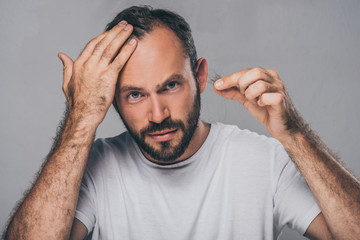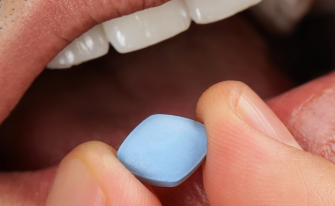Alopecia areata (alopecia = bald, areata = patchy), a condition also known as patchy hair loss is a fairly common condition that affects nearly 147 million people worldwide. Regardless of age, sex, or race, it affects just over 2% of people at some point in their life – that’s approximately 1 in every 50 people. So let’s dive deeper into what this condition is and what you can do about it.
What is it?
Alopecia areata is an autoimmune skin condition that causes sudden loss of hair, leaving hairless patches usually on the scalp but also other parts of the body. Hair generally falls out in clumps the size and shape of a coin, and while some individuals see hair loss in only a few spots, others see many.
Fortunately, the hair loss itself is not painful: individuals diagnosed with alopecia can lead a normal, healthy life. But the psychological effects that follow can take a toll on one’s confidence, self-esteem and even quality of life.
While alopecia areata is the most common form, there are actually different types of balding. Some include:
-Alopecia totalis: an advanced form of alopecia areata that results in the complete loss of hair on the scalp.
-Alopecia universalis: a rare form of alopecia areata that causes hair loss across the entire body, scalp, and hair (eyelashes and eyebrows included)
-Diffuse alopecia areata: instead of hair patches, it’s the sudden and unexpected thinning of the hair on the scalp
-Ophiasis alopecia: unique pattern on hair loss in a band shape across the back and sides of the scalp
What causes alopecia areata?
Sometimes the immune system attacks a certain part of the body – in this case, it’s the hair follicles that the body mistakenly sees as foreign invaders and attacks them. When these hair follicles are targeted, it prevents the growth of hair in these areas, leaving behind hairless patches. Interestingly, it’s not quite clear what triggers the immune system to attack healthy hair follicles, and scientists are yet to find the root cause.
What are the symptoms?
While the main symptom of alopecia areata is simply sudden hair loss in coin-sized patches, but there are other signs you can look out for:
-Hair begins to regrow on its own in the same spot it originally fell out from
-Hair loss occurs during colder temperatures & in the winter time
-Hairless patches enlarge and merge together to form irregular bald spots
-A lot of hair loss over short period of time
-Fingernails appear brittle, pitted with lines, and with white spots
Is alopecia areata genetic?
Because there are many factors that are involved, both genetic and environmental, it’s difficult to pin down the inheritance pattern for alopecia. While it’s unclear, scientists have found that the risk of developing alopecia is far greater for family members (children and siblings) of the affected. Nearly 20% of individuals who are affected have first-degree relatives who also have alopecia areata.
Alopecia areata is a ‘polygenic’ disease. This means that it takes multiple different predisposition genes for the condition to arise. The interaction between these specific genes is complex, so it’s highly unlikely for a child to inherit the exact genes that predispose them to alopecia. For this reason, the majority of affected parents do not pass it onto their kids and most people who have alopecia do not have parents with it.
Permanent or reversible?
Currently, there is no known cure for alopecia areata but there’s a glimmer of hope. The condition is non-scarring so the hair follicle suffers no permanent damage and still have the ability to regrow hair. The follicles are still alive and ready to resume normal hair production when given the right signal – regardless of how widespread the hair loss is or after years of extensive hair loss. Those affected with alopecia areata will generally regrow hair over the affected spots. In fact, 50% of those with mild alopecia see regrowth within a year – though the condition tends to re-appear more than once during their lifetime.
Okay so you have it – now what?
If you’ve decided you want to rid yourself of this condition, there are a variety of treatments available to slow down and reverse hair loss. Treatment options usually work by either distracting or disrupting the immune system so that they don’t attack the hair follicles. Here’s some common treatment options:
-Topical minoxidil: Applied to the scalp, a 2% or 5% minoxidil solution promotes hair growth by lengthening the hair growth phase of follicles. When used correctly, hair growth can be seen in as low as 12 weeks. Minoxidil is already used for male pattern baldness, and it’s usually combined with corticosteroids to maximise results.
-Corticosteroids: Prescribed in many different forms (injections, topical creams, pills), corticosteroids are anti-inflammatory medications that are used to treat autoimmune diseases like alopecia areata. They reduce inflammation around the hair follicle and counteract the effects of an autoimmune disorder, thereby stimulating hair growth.
-Topical immunotherapy: This treatment involves applying chemicals to the area of hair loss (scalp) to cause an allergic reaction. This reaction alters the immune response and results in either itching or irritation which induces hair growth – for reasons that are still unclear.
-Anthralin: Widely used for another skin condition, psoriasis, anthralin is also used to treat patients with mild alopecia areata. Applied directly onto the bald spots, it can show hair growth in three to four months.
Alopecia: the bottom line
If you have alopecia areata, you are not alone. While it’s not life-threatening, nor does it cause physical pain, living with alopecia may bring about its own set of social and emotional challenges. But it’s important to seek help from medical professionals and keep all your options open before embarking on your hair growth journey.
References:
https://www.webmd.com/skin-problems-and-treatments/guide/alopecia-areata
https://www.uptodate.com/contents/alopecia-areata-beyond-the-basics#H1
https://www.naaf.org/alopecia-areata
https://medlineplus.gov/genetics/condition/alopecia-areata/#resources

Mature Hairline Vs Receding: Pictures & Signs
It’s a nightmare for men to see a change in their hairline. It makes them wonder if it’s the natural way of aging or the

How to Prevent and Stop Receding Hairline: Proven Techniques
It all starts with a glance in the mirror. First, a slightly higher corner. Then the hairline starts creeping back. Before you know it, you’re

What is a Mature Hairline? Looks, Causes, and Solutions
A mature hairline can feel like a rite of passage—something that happens gradually and often goes unnoticed until one day, you realize your hairline has



















 (US)
(US)



